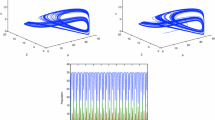Abstract
The present paper deals with the bifurcation analysis of a simple food chain model consisting of components like detritus, nutrients, microorganisms, phytoplankton and zooplankton in an aquatic environment. The food chain model is described by a system of differential equations. If the length of the food chain (LFCH) is equal to 3 or 4, then an asymptotically stable equilibrium exists. For LFCH=5 or 6 the non-trivial equilibrium is unstable and the food-chain model has periodic orbits.
Similar content being viewed by others
References
Anderson, R. V., D. C. Coleman, C. V. Cole, E. T. Elliott, and J. F. McClellan. 1979. The use of soil microcosms in evaluating bacteriophagic nematode responses to other organisms and effect on nutrient cycling.Int. J. Environmental Studies 13, 175–182.
Bhatia, N. P. and G. T. Szegő. 1970.Stability Theory of Dynamical Systems. New York: Springer.
Busenberg, S., S. K. Kumar, P. Austin, and G. Wake. 1990. The dynamics of a model of a plankton-nutrient interaction.Bull. Math. Biol.,52, 677–696.
Butler, G. J., S. B. Hsu, and P. Waltman. 1983. Coexistence of competing predators in a chemostat.J. Math. Biol. 17, 133–151.
DeAngelis, D. L. 1980. Energy flow, nutrient cycling and ecosystem resilience.Ecology 61, 764–771.
Dudzik, M., J. Harte, E. Jassby, E. Lapan, D. Levy, and J. Rees. 1979. Some consideration in the design of aquatic microcosms for plankton studies.Int. J. Environmental Studies 13, 125–130.
Freedman, H. I. and J. W. H. So. 1985. Global stability and persistence of simple food chain.Math. Biosci. 76, 69–86.
Gantmacher, F. R. 1959.The Theory of Matrices, Vol. 2. New York: Chelsea.
Giddings, J. M. and G. K. Eddlemon. 1979. Some ecological and experimental properties of complex aquatic microcosms.Int. J. Environmental Studies 13, 119–123.
Hofbauer J. and K. Sigmund. 1988.The Theory of Evolution and Dynamical Systems, p. 341. Cambridge: Cambridge University Press.
Horward, L. N. 1979. Nonlinear oscillations. InNonlinear Oscillation in Biology. Lectures in Applied Mathematics, F. R. Hoppenstead (Ed), Vol. 17, pp. 1–69. Providence, RI: American Mathematical Society.
Kmeť, T. 1986. Dynamic ecological system models. Ph.D. thesis, Center of Biological Ecological Sciences, Slovak Academy of Sciences, Bratislava, (in Slovak with English summary).
Leonov, A. 1980. The chemical-ecological modelling of aquatic nitrogen compound transformation processes. HASA WP 80-86, HASA Laxenburg, Austria.
Mardsen, J. E. and M. McCracken M.. 1976.The Hopf Bifurcation and Its Applications, p. 408. New York: Springer-Verlag.
May, R. M. 1973. Mass and energy flow in closed ecosystems: a comment,J. Theor. Biol. 37, 155–163.
Nisbet, R. M. and W. S. C. Gurney. 1976. Model of material cycling in a closed ecosystem.Nature (London) 264, 633–634.
Nisbet, R. M., J. McKinstry, and W. S. C. Gurney, 1983. A strategic model of material cycling in a closed ecosystem.Math. Biosci. 64, 99–113.
Rapp, P. E., R. A. Latta, and A. I. Mees. 1988. Parameter-dependent transitions and the optimal control of dynamical diseases.Bull. Math. Biol. 50, 227–253.
Smith, H. L. 1982. The interaction of steady state and hopf bifurcations in a two-predatorone-prey competition model.SIAM J. Appl. Math. 42, 27–43.
Ulanowicz, R. E. 1972. Mass and energy flow in closed ecosystems.J. Theor. Biol. 34, 239–253.
Wroblewski, J. S., J. L. Sarmiento, and G. R. Fliel. 1988. An ocean basin scale model of plankton dynamic in the North Atlantic. Solutions for the climatological oceanographic condition in May.Global Biogeochem. Cycles 2, 199–218.
Author information
Authors and Affiliations
Rights and permissions
About this article
Cite this article
Kmeť, T. Material recycling in a closed aquatic ecosystem. II. Bifurcation analysis of a simple food-chain model. Bltn Mathcal Biology 58, 983–1000 (1996). https://doi.org/10.1007/BF02459493
Received:
Accepted:
Issue Date:
DOI: https://doi.org/10.1007/BF02459493




